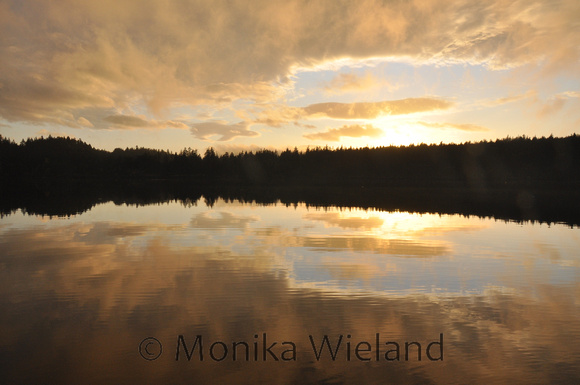Yesterday (Sunday) was my birthday, and this year I got an extended celebration with a weekend trip to a nearby Orcas Island. When we got on the ferry on Friday afternoon it was pouring rain, and I figured that at least we had a nice cabin to stay in and watch the showers if that's what the weekend had in store. By the time we pulled in to the Orcas ferry landing, however, it had slowed to a drizzle, and by the time we drove to Cascade Lake the rain had stopped altogether. We decided to hike the 2.7 mile trail around the lake, and the weather mostly held off. There were still lots of low-lying clouds hanging in the trees around the lake, making for some especially scenic (and iconic Pacific Northwest) views.
There were lots of Pacifc wrens, golden-crowned kinglets, dark-eyed junocs, and chestnut-backed chickadees in the woods. We even saw a bald eagle fly out of the forest, but the lake itself was pretty empty until we came to this bridge that separated the main part of the lake from a smaller offshoot. In this more protected cove we saw a flock of about twenty ring-necked ducks, four hooded mergansers, and three pied-billed grebes. Nearby were also some bufflehead and double-crested cormorants.
As we neared the end of the hike, we noticed it was getting lighter. As the sun was getting lower in the sky, it started to shine through a break in the clouds, changing the scene from the foggy one above to the bright one below:
The reflections in the water were really amazing: the near-perfect mirror image of the scenery was only disturbed the water droplets falling from the branches, creating a ripple effect across the surface. Once we got back to the car, the late afternoon light was especially stunning.
We got to our cabin just before sunset proper, and settled in for a nice evening including a spaghetti dinner, a fire in the wood stove, and a dip in the outdoor hot tub where the only sound you could hear was the gentle waves crashing on the nearby shoreline.
Despite a forecast for rain, I was thrilled when we woke up the next morning and the clouds started to clear shortly after sunrise. After going out for a nice breakfast, we made our way up Mt. Constitution, the highest point in the San Juan Islands at about 2,400 feet. There were still some clouds up there, and the summit was actually above the clouds, which again made for some interesting, ever-changing views.
Even up here the sun was starting to work its way through the clouds:
There wasn't a lot of bird activity up here. We heard a common raven, a flock of red crossbills flew by a couple of times, and we heard and saw several Pacific wrens. The wrens sure seem to be around in great numbers right now! They're one tiny forest dweller.
After our excursion to Mt. Constitution we decided to spend the rest of the day at the cabin. There were some hiking trails on the property there and a great view out the front windows into a secluded bay. Next up - some wildlife and scenic highlights from around the cabin!








































